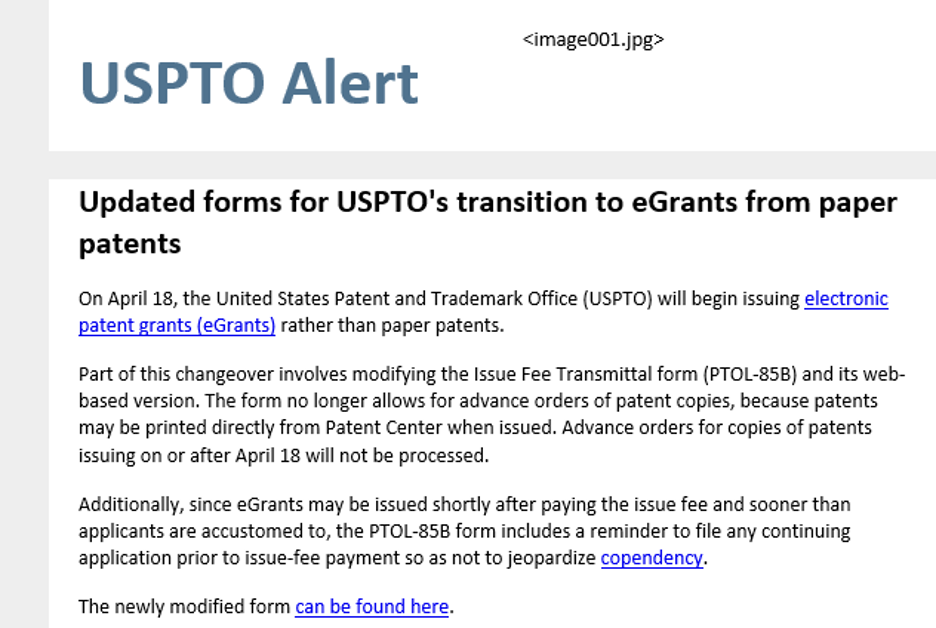

March 23, 2023, 07:15 AM 9
“In the past…it took about two to three weeks for a patent to grant from the time the issue fee was paid. However, this is going to change as of April 18, and thus the ‘time buffer’ for filing a continuation, CIP, and/or divisional application will no longer exist.”
The United States Patent and Trademark Office (USPTO) sent out the following alert via an email on March 16, 2023:

This change to electronic patent grants as opposed to paper patents is in accord with the USPTO’s continued changes to an all-electronic and no paper system. Prior changes have included all-electronic office actions, and of course the USPTO’s EFS-Web system, in which filings are made electronically with the USPTO.
One important thing to realize is that a patent may grant very soon after payment of the issue fee, so if the Applicant desires to have a continuation, continuation-in-part (CIP), and/or divisional application filed (all such applications are referred to as “continuing applications”), they should really do so before or at the same time the issue fee is paid, in order to maintain the pendency with the to-be-issued patent.
In the past, based on what the author has experienced, it took about two to three weeks for a patent to grant from the time the issue fee was paid. However, this is going to change as of April 18, and thus the ‘time buffer’ for filing a continuation, CIP, and/or divisional application will no longer exist.
As such, patent attorneys should docket the filing of a continuation, CIP, and/or divisional application at the same time when the issue fee is filed, so that the loss of priority will not occur. The filing of continuation, CIP, and/or divisional applications is limited by the co-pendency requirement of 35 U.S.C. § 120, which stipulates that each subsequent application cannot be filed after the issuance, expiration, or abandonment of the parent application from which it immediately depends.
Will the USPTO issue a patent a day after the issue fee is paid on an application? Who knows, but to be safe, one should assume that this will occur, and have the continuation, CIP, and/or divisional application already filed with the USPTO.
Of course, all clients should be notified of this change ASAP, so that they can provide instructions for filing a continuation, CIP, and/or divisional application earlier than they have in the past. If an Applicant wants to file a continuation, CIP, and/or divisional application but has not provided a new set of claims to include in that application, then there are several approaches that can be adopted. One approach is to file a placeholder claim, such as original claim 1 of the application that will be granted, and another approach is to file a claim similar to or exactly the same as patented claim 1 of the patent to be granted. In either case, one should follow up soon thereafter with a preliminary amendment with the desired set of claims, so as not to get a first Office Action with a 35 USC § 101 ‘same invention’ rejection is the event that the patent examiner assigned to the new continuation, CIP, or divisional application acts on the application very soon after it is filed with the USPTO.
Image Source: Deposit Photos
Image ID: 84032870
Author: gustavofrazao
At IPWatchdog, we are dedicated to providing in-depth analysis, news, and educational content on intellectual property law and policy. As an independent media company, we rely on the support of our sponsors and our community to maintain the quality and accessibility of our resources. Your donation enables us to continue our mission, ensuring that innovators, attorneys, and enthusiasts have access to the latest insights and developments in the field. By donating, you are not only helping us sustain our operations but also contributing to the growth and advancement of the intellectual property community.
Every contribution, no matter the size, is greatly appreciated and makes a difference.